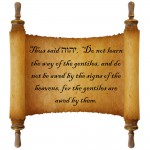We have established that we should keep the sabbatical year, even if we are not living in Israel. The following question we need to answer for ours elves then is: Exactly, when is the next sabbatical year? Do we even know? The answer is yes, but it is not straight forward. You will need to do some digging in your Bible and the history books to find the answers. Let us go and find the answer.
elves then is: Exactly, when is the next sabbatical year? Do we even know? The answer is yes, but it is not straight forward. You will need to do some digging in your Bible and the history books to find the answers. Let us go and find the answer.
Prepare yourself for a detailed and somewhat technical discussion to prove this important point.
Before you can do any serious investigations into any historical chronologies, you first need to learn that we have many different calendars to deal with; all of them correct and a lot of them referring to the same time period. Every culture that dominates the world feels the need to create their own “new” way of keeping track of time. This makes live a bit more complicated for us, when we need to link the timelines of two sources together. However, why do we need different sources? Does the Bible not contain everything we need (sola scriptura)? When it comes to tracking the chronology, it is always good to find more details in extra -biblical sources. In this study, we will need to jump into some of these to find the proof we need to confirm what the Bible is telling us and to place it within these other chronologies.
Sources of information
In addition to our Bible we will also need:
1. The book of the Maccabees (1 Maccabees) – Most of you will be aware of a very small part of this book from the story of Chanukah. The books of 1 & 2 Maccabees are part of the Apochrophya of the Old Testament. It provides us with the details of the struggle that the Jewish people had in the period between Ezra & Nehemiah and John the Baptist. In this document we find a chronology of the wars between the Maccabees and the oppressors of the Jewish people, including Antiochus IV (Epiphanes).
2. The Antiquities of the Jews by Josephus Flavius; Josephus Flavius aka Joseph ben Matityahu (37 – c. 100 CE) is a Jewish historian who has recorded for us the history of the Jewish nation. He was of priestly descend and served as a general in the first Jewish war of 66-73 C.E.
After the Jewish garrison of Yodfat fell under siege, the Romans invaded, killing thousands; the survivors committed suicide. Josephus surrendered to the Roman forces and became a prisoner. In 71, he went to Rome in the entourage of Titus, becoming a Roman citizen and client of the ruling Flavian dynasty (hence he is often referred to as Flavius Josephus – see below). In addition to Roman citizenship, he was granted accommodation in conquered Judaea, and a decent, if a not extravagant, pension. While in Rome and under Flavian patronage, Josephus wrote all of his known works. His most important works were The Jewish War (c. 75 CE) and Antiquities of the Jews (c. 94 CE). “Antiquities of the Jews,” recounts the history of the world from a Jewish perspective for an ostensibly Roman audience. These works provide valuable insight into 1st century Judaism and the background of Early Christianity.
Both these works are not copyrighted and copies (including audio books) can be found for free on the internet.
Calendars
When reading these resources and trying to put together a timeline of events, in order to determine the exact month/season and year of a described event, it is important to remember that these sources (Bible, Apochophya and Works of Josephus) all use different methods of reckoning time. Let us take a quick view of the major calendars that impact this study of ours. In each calendar I have highlighted the start of the year in red.
|
Season |
Month Nr. |
Month names |
|
|
Macedonian(#) |
|
|
|
|
|
Babylonian |
Babylonian (translit) |
Hebrew (post Babylonian) |
earlier correlation |
later correlation (used by Seleucid calendar) |
Approximate Julian Equivalent (also used for Gregorian) |
|
Reš Šatti (beginning of year) |
I |
|
Nīsannu |
Nisan |
Artemisios |
Xanthikos |
March-April-May |
|
|
II |
|
Ayyāru |
Iyar |
Daisios |
Artemisios |
April-May-June |
|
|
III |
|
Simannu |
Sivan |
Panemos |
Daisios |
May-June-July |
|
|
IV |
|
Du’ūzu |
Tammuz |
Loös |
Panemos |
June-July-August |
|
Mišil Šatti (middle of year) |
V |
|
Ābu |
Ab |
Gorpiaios |
Loös |
July-August-September |
|
|
VI |
|
Ulūlū |
Elul |
Hyperberetaios |
Gorpiaios |
August-September-October |
|
|
VII |
|
Tašrītu |
Tishri |
Dios |
Hyperberetaios |
September-October-November |
|
|
VIII |
|
Arahsamna |
Marheshvan |
Apellaios |
Dios |
October-November-December |
|
Kīt Šatti (end of year) |
IX |
|
Kisilīmu |
Kislev |
Audynaios |
Apellaios |
November-December-January |
|
|
X |
|
Tebētu |
Tebet |
Peritios |
Audynaios |
December-January-February |
|
|
XI |
|
Šabātu |
Shevat |
Dystros |
Peritios |
January-February-March |
|
|
XII |
|
Addāru |
Adar |
Xanthikos |
Dystros |
February-March-April |
|
Intercalary |
XIII |
Except in year 17 of 19-year cycle, when intercalary month was after Ulūlu. |
Makaruša Addari |
Adar II |
|
|
|
Months
We currently use the Gregorian calendar for our reckoning of time, which in turn is based on the Julian calendar shown above. It was introduced by Pope Gregory XIII, after whom the calendar was named, by a decree signed on 24 February 1582. The reformed calendar was adopted later that year by a handful of countries, with other countries adopting it over the following centuries. The motivation for the Gregorian reform was that the Julian calendar assumes that the time between vernal equinoxes is 365.25 days, when, in fact, it is presently almost exactly 11 minutes shorter. Between AD 325 (when the Roman Catholic Church thought the First Council of Nicaea had fixed the vernal equinox on 21 March), and the time of Pope Gregory’s bull in 1582; the vernal equinox had moved backward in the calendar, until it was occurring on about 11 March, 10 days earlier. The Gregorian calendar, therefore, began by skipping 10 calendar days, to restore March 21 as the date of the vernal equinox. The Gregorian calendar continued the previous year-numbering system (Anno Domini), which counts years from the traditional date of the nativity, originally calculated in the 6th century and in use in much of Europe by the High Middle Ages. This system is the predominant international standard today.
The Ancient Macedonian calendar is a luni-solar calendar that was in use in ancient Macedon in the 1st millennium BC. It consisted of 12 synodic lunar months (i.e. 354 days per annum), which needed intercalary months to stay in step with the seasons. By the time the calendar was being used across the Hellenistic world, seven total embolimoi (intercalary months) were being added in each 19-year Metonic cycle. The names of the ancient Macedonian Calendar remained in use in Syria even into the Christian era. This calendar was, in essence, the Babylonian calendar with the substitution of Macedonian names for Babylonian ones. Under the Seleucid Empire, the Macedonians adopted the Seleucid era. The year beginning on the 1st of Dios during what we call October 312 BCE was declared to be the year one of the Seleucid era. Epigraphical and numismatical sources indicate that between 31 CE and 46/47 CE, the correlation of the Macedonian months with the Babylonian months underwent a shift of one month as shown in the table above.
1 Maccabees uses the Hebrew method for determining the start of the new year. This can be seen in 1 Maccabees 4:52 that states:
“early in the morning on the twenty-fifth (day) of the ninth month, which is the month Chislev, in the one hundred and forty-eighth year“
This points us clearly to the fact that the author of this book considered the start of the year in Nissan.
In his documents, Josephus normally provides us with a fairly good indication of which month of which calendar he is referring to. He makes specific mention to the Hebrew month and the Seleucid calendar (based on the Babylonian, which is based on the Macedonian) to provide his readers a clear indication of which exact year the event took place. For example:
Antiquities 12:7.6
So on the five and twentieth day of the month Casleu, which the Macedonians call Apelleus, they lighted the lamps that were on the candlestick, and offered incense upon the altar [of incense], and laid the loaves upon the table [of shewbread], and offered burnt offerings upon the new altar [of burnt offering].
Counting of years
Seleucid
The Seleucid era was a system of numbering years in use by the Seleucid Empire and other countries among the ancient Hellenistic civilizations. The era dates from the return of Seleucus I Nicator to Babylon in 311 BC after his exile in Ptolemaic Egypt, considered by Seleucus and his court to mark the founding of the Seleucid Empire. The introduction of the new era is mentioned in one of the Babylonian Chronicles, the Chronicle of the Diadochi.
Two different uses were made of the Seleucid years:
1. The natives of the empire used the Babylonian calendar, in which the new year falls on 1 Nisanu (3 April in 311 BC), so in this system year 1 of the Seleucid era corresponds roughly to April 311 BC to March 310 BC.
2. The Macedonian court adopted the Babylonian calendar (substituting the Macedonian month names) but reckoned the new year to be in the autumn (the exact date is unknown). In this system year 1 of the Seleucid era corresponds to the period from autumn 312 BC to summer 311 BC.
These differences in the beginning of the year mean that dates may differ by one. Bickerman gives this example:
For instance, the restoration of the temple of Jerusalem by Judas Maccabeus, approximately 15 December 164 BC, fell in the year 148 of the Seleucid Era according to Jewish (and Babylonian) calculation, but in the year 149 for the court.
Greek Olympiad
An Olympiad is a period of four years, associated with the Olympic Games of Classical Greece. In the Hellenistic period, beginning with Ephorus, Olympiads were used as calendar epoch. In this reckoning, the first Olympiad lasted from the summer of 776 BC to that of 772 BC.
Some example of the mapping the Julian/Olympiad/Seleucid calendars is as follows:
| Seleucid Year(Babylonian Era) | Julian(B.C.) | Olympiad | Olympic Year |
|
140 |
172 |
152 |
1 |
|
141 |
171 |
2 |
|
|
142 |
170 |
3 |
|
|
143 |
169 |
4 |
|
|
144 |
168 |
153 |
1 |
|
145 |
167 |
2 |
|
|
146 |
166 |
3 |
|
|
147 |
165 |
4 |
|
|
148 |
164 |
154 |
1 |
|
149 |
163 |
2 |
|
|
150 |
162 |
3 |
|
|
151 |
161 |
4 |
http://www.tyndalehouse.com/egypt/ptolemies/chron/olympic/chron_ol_cal_fr.htm
The book of Maccabees uses the Seleucid year counting and uses Nisan as the start of their year. Thus, the text we had earlier describing the rededication of the temple puts us in the year 164 B.C around December.
1 Maccabees 4:52
“early in the morning on the twenty-fifth (day) of the ninth month, which is the month Chislev, in the one hundred and forty-eighth year”
puts us in the year 164 B.C around December. A more precise dating (precise day) is possible based on the lunar cycles, but this calculation is beyond the scope of this article.
When Josephus describes the same event he dates it as follows:
Anitquities 12:7.6 (321)
This desolation happened to the temple in the hundred forty and fifth year, on the twenty-fifth day of the month Apelleus, and on the hundred and fifty-third olympiad: but it was dedicated anew, on the same day, the twenty-fifth of the month Apelleus, in the hundred and forty-eighth year, and on the hundred and fifty-fourth olympiad.
Finding the sabbatical years
Now that we have the sources, and we are familiar with some of the complexities of bringing all the sources together. Let us find the references that describe a sabbatical year. I have reviewed these resources and have come up with the following sabbatical years, plus the reference that nominates it as a sabbatical year.
| Gregorian Year | Source Reference | Quote |
| 701B.C. | 2 Kings 19:29 Isaiah 37:30 |
|
| 456 B.C | Nehemiah 5:7-13 Nehemiah 8:18 |
|
| 162 B.C | 1 Mac 6:20,48-54; Josephus Antiquities 12.9.5 (12.378) seige of Bethzura and Jerusalem |
1 Maccabees 6:20 They gathered together and besieged the citadel in the one hundred fiftieth year; and he built siege towers and other engines of war.1 Maccabees 6:48-54 48 The soldiers of the king’s army went up to Jerusalem against them, and the king encamped in Judea and at Mount Zion. 49He made peace with the people of Beth-zur, and they evacuated the town because they had no provisions there to withstand a siege, since it was a sabbatical year for the land. 50 So the king took Beth-zur and stationed a guard there to hold it. 51 Then he encamped before the sanctuary for many days. He set up siege towers, engines of war to throw fire and stones, machines to shoot arrows, and catapults. 52 The Jews also made engines of war to match theirs, and fought for many days. 53 But they had no food in storage, because it was the seventh year; those who had found safety in Judea from the Gentiles had consumed the last of the stores. 54Only a few men were left in the sanctuary; the rest scattered to their own homes, for the famine proved too much for them. Josephus Antiquities 12.9.5 |
| 134 B.C | 1 Mac 16:14, Josephus Antiquities 13.8.1 (13.233–235) |
1 Macc 16.14 Now Simon was visiting the cities that were in the country, and taking care for the good ordering of them. And he went down to Jericho, he himself and Mattathias and Judas, his sons, in the one hundred and seventy-seventh year, in the eleventh month, the same is the month Sebate. Josephus Antiquities 13.8.1 |
| 43 B.C | Josephus Antiquities 14.10.5-6 (14.200-204) | Josephus Antiquities 14.10.5. (200) ‘Caius Caesar, consul the fifth time, hath decreed, That the Jews shall possess Jerusalem, and may encompass that city with walls; and that Hyrcanus, the son of Alexander, the high priest and ethnarch of the Jews, retain it, in the manner he himself pleases; (201) and the Jews be allowed to deduct out of their tribute, every second year the land is let [in the Sabbatic period], a corus of that tribute; and that the tribute they pay be not let to farm, nor that they pay always the same tribute.Josephus Antiquities 14.10.6 (202) ‘Caius Caesar, imperator the second time, hath ordained, That all the country of the Jews, excepting Joppa, do pay a tribute yearly for the city Jerusalem, excepting the seventh, which they call the Sabbatical Year, because thereon they neither receive the fruits of their trees, nor do they sow their land; (203) and that they pay their tribute in Sidon on the second year [of that Sabbatic period], the fourth part of what was sown: and besides this, they are to pay the same tithes to Hyrcanus and his sons, which they paid to their forefathers. (204) And that no one, neither president, nor lieutenant, nor ambassador, raise auxiliaries within the bounds of Judea, nor may soldiers exact money of them for winter quarters, or under any other pretense, but that they be free from all sorts of injuries:This speech was made in April 44B.C. Thus 44/43 BC would be the first year and 43/42 B.C. would be the second year where the Jewish Sabbath year would be kept. |
| 36 B.C. | Josephus Antiquities 14.16.2 (14.475) | Josephus Antiquities 14.16.2 They also erected new works when the former were ruined, and making mines under ground, they met each other, and fought there; and making use of brutish courage rather than a prudent valor, they persisted in this war to the very last; and this they did while a mighty army lay round about them, and while they were distressed by famine and the want of necessaries, for this happened to be a Sabbatic Year. |
| 22 B.C. | Josephus Antiquities 15.9.1 (15.302-303) | Josephus Antiquities 15.9.1 (302) When therefore the fruits of that year were spoiled, and whatsoever they had laid up beforehand was spent, there was no foundation of hope for relief remaining, but the misery, contrary to what they expected, still increased upon them; and this, not only on that year, while they had nothing for themselves left [at the end of it], but what seed they had sown perished also, by reason of the ground not yielding its fruits on the second year. (303) This distress they were in made them also out of necessity, to eat many things that did not use to be eaten; nor was the king himself free from this distress any more than other men, as being deprived of that tribute he used to have from the fruits of the ground; and having already expended what money he had, in his liberality to those whose cities he had built; This famine for two years that affected Judea and Syria, the thirteenth and fourteenth years of Herod, which are the twenty-third and twenty-fourth years before the Christian era(Gregorian Calendar), seems to have been more terrible during this time that was that in the days of Jacob, Gen. 41-42. And what makes the comparison the more remarkable is this:”That now, as well as then, the relief they had was from Egypt also; then from Joseph the governor of Egypt, under Pharaoh, king of Egypt; and now from Petronius the prefect of Egypt, under Augustus, the Roman emperor. See almost the like case, Antiq. 20.2.6. It is also well worth our observation here, that these two years were a Sabbatic Year, and a year of jubilee, for which Providence, during the theocracy, used to provide a triple crop beforehand; but which became now, when the Jews had forfeited that blessing, the greatest years of famine to them ever since the days of Ahab. 1 Kings. 17-18. |
| 133 & 140 C.E. | Mur 24E | Two Sabbatical Years connected with the Bar Kochba Revolt. Bar Kochba made a land lease agreement in the second year of his revolt specifying 5 years of harvest to be followed by the Sabbatical year. A rental contract, written in Hebrew, dated to the era of the Bar Kochba revolt (labeled as “Mur 24E”), show that in the second year of the revolt five years of harvest would be collected before the next Sabbatical year. This contract was found among several contracts in the caves of Wadi Murabba’ (also known as Nahal Darga) in the Judean Desert near Bethlehem. This property was seized by the Jews during the revolt. They are dated on Shevat 20, year two of the Kochba revolt. Both Eusebius ( Ecclesiastical History IV 6) and the best manuscripts of the Seder Olam point to the sixteenth year of Hadrian as the specific year that the Jewish revolt began, i.e. 133 C.E. |
Comments on specific years
Let us review some of these dates in a bit more detail:
701 B.C.
How do we know that the scripture of 2 Kings 19:29 points to this specific year? 2 Kings 18 & 19 covers the attack of King Sennacherib of Assyria on the city of Jerusalem during the 14th year of King Hezekiah. This is done after he has conquered the city of Lachish during the “Siege of Lachish“. At the request of King Hezekiah, Isaiah prays to YHVH to save the city. YHVH gives Isaiah and King Hezekiah the re-assurance that they will not be defeated by the Assyrians. Verse 19 is then given as a sign to confirm the message. We know that the only way we can have two years with no planting, and sowing is if we have a jubilee year that is preceded by the sabbatical year. Thus, the year the sign is given is the sabbatical year that precedes the jubilee year. Now how do we know the year number? The siege and capture of Lachish, one of the fortress towns protecting the approaches to Jerusalem, is unique in that it is mentioned in the Old Testament (2 Kings 18; 2 Chronicles 32) and in the Annals of the Assyrian king, Sennacherib. Not only, is it that, but the event is also depicted on the walls of Sennacherib’s palace at Nineveh. The capture of Lachish was evidently an event of considerable importance to the king for he devoted an entire room to the composition. These reliefs are presently housed in the British museum in London. The details are also recorded on Sennacherib’s Hexagonal Prism that was discovered among the ruins of Nineve by Colonel Taylor in 1830. As per the prophecy provided by Isaiah, King Sennacherib dies after his attack on Jerusalem (2 Kings 19:37). The Assyrians kept track of their years by making use of Limmu, an Assyrian eponym. Each year was named after a high official (Limmu). These eponym lists are well documented in 19 exemplars that list in excess of 50 names of Limmu. It thus provides us an accurate way of dating Assyrian event between 901B.C and 649 B.C. We tie this back to the year number by the full solar eclipse that happened on 15 June 763 B.C and was recorded by a scribe from Ninive on the eponomy of Bur-Sagale by an Assyrian historical record known as the Assyrian Eponym Canon. (See solar eclipse charts of this time from NASA here) The Assyrian eclipse is also known as Bur-Sagale eclipse. It was recorded in Assyrian eponym lists, most likely in the 9th year of King Ashur-dan III. The actual short entry reads as follows:
Bur-Sagale of Guzana, revolt in the city of Assur. In the month Simanu an eclipse of the sun took place.
The date of an eclipse referred to in the Bible is known for certain:
Amos 8:9
9 “It will come about in that day,” declares the YHVH Elohim, “That I will make the sun go down at noon And make the earth dark in broad daylight.”
In addition to the Assyrian records, Edwin Richard Thiele could double check his accuracy with the canon of Claudius Ptolemy (70-161 A.D.). This canon, called Almagest, recorded astronomically dated history from Nabonassar era in 747 B.C. up through all the Babylonian, Persian kingdoms as well as and up to Alexander the Great. Ptolemy provided a large number of solar, lunar and planetary positions with their dates, and over 80 of these have been verified by modern astronomers. Thiele was again able to confirm the eclipse date of 763 B.C. from Ptolemy’s canon, and found many other cross references between Assyrian records and Ptolemy’s canon.
With this eponym fixed, it is possible to match all the canon of Assyrian kings right up to the year that Sennacherib conquers Lachish and attacks Jerusalem.
456 B.C.
The year the walls of Jerusalem were rebuilt, and the law was again read to the nation during the feast of Sukkot as determined in Deut 30:10-11. Now how do we know which year the law was read to the nation? From Josephus and the book of 1 Esdras we know when Ezra arrived in Jerusalem:
Antiquities 11.5.2
(135) for Esdras had said beforehand, that he had told the king how YHVH would preserve them, and so he had not thought fit to request that he would send horsemen to conduct them. So when they had finished their prayers, they removed from Euphrates, on the twelfth day of the first month of the seventh year of the reign of Xerxes, and they came to Jerusalem on the fifth month of the same year.
1 Esdras 8:6
6 in the seventh year of the reign of Artaxerxes, in the fifth month (this was the king’s seventh year); for they left Babylon on the new moon of the first month and arrived in Jerusalem on the new moon of the fifth month, by the prosperous journey that YHVH gave them.
Ezra had to deal with the issue of mixed marriages with pagan wives later that year. The meeting to discuss this was held on the twentieth day of the ninth month:
Antiquities 11.5.4Â
(148) and when proclamation was made, that all those of the captivity should gather themselves together to Jerusalem, and those that did not meet there in two or three days should be banished from the multitude, and that their substance should be appropriated to the uses of the temple, according to the sentence of the elders, those that were of the tribes of Judah and Benjamin came together in three days, viz., on the twentieth day of the ninth month, which, according to the Hebrews, is called Tebeth, and according to the Macedonians, Apelleius.
The elders then agreed to resolve the problem and asked for some time to resolve this. They would start their investigation on the new moon of the tenth month and would continue until the new moon of the next month.
Antiquities 11.5.4
(151) Accordingly, this was resolved on by them; and they began the inquiry after those that had married strange wives on the first day of the tenth month, and continued the inquiry to the first day of the next month, and found a great many of the posterity of Jeshua the high priest, and of the priests and Levites, and Israelites,
According to Ezra this process continued until the first month of the next year:
Ezra 10:17
17 They finished investigating all the men who had married foreign wives by the first day of the first month.
This would then bring us to the eight year of the reign of Xerxes (called by the Greeks – Artaxerxes Longimanus)
Now we read next in Josephus and Nehemiah 8.18 that they keep the feast of Sukkot in the seventh month and that the scroll is read to the nation.
Antiquities 11.5.5
(154) Now when they kept the feast of tabernacles in the seventh month, and almost all the people were come together to it, they went up to the open part of the temple, to the gate which looked eastward, and desired of Esdras that the laws of Moses might be read to them. (155) Accordingly, he stood in the midst of the multitude and read them; and this he did from morning to noon. Now, by hearing the laws read to them, they were instructed to be righteous men for the present and for the future; but as for their past offenses, they were displeased at themselves and proceeded to shed tears on their account, as considering with themselves, that if they had kept the law, they had endured none of these miseries which they had experienced
The book of 1 Esdras confirms these same dates, making it three different sources that now confirm these dates. These dates are based on the Babylonian method of measuring a king’s reign from the year of accession which always starts on the first of Nissan. Artaxerxes defeated Artabanus in June 464 B.C. to recover the throne of his father, Xerxes the great. On the first of Nisan 463 B.C. Artaxerxes would have been recognized as the king of Babylon. Thus the start of the eight year of Artaxerxes brings us to the first of Nisan 456 B.C.
o Please note that Nehemiah uses the Persian custom of counting a king’s years. This would add the eight years that Artaxerxes co-reigned with his farther to his years, causing Nehemiah to mention this as the 28th year. Both the Persians and Babylonians started their year count in Nisan.
Conclusion
Thus based on this reference points we can establish the sabbatical years from multiple sources. This allows us to extrapolate these years and determine that the next sabbatical year would be in the year 2016.
Now that we know this, our next step has to be to investigate the ways in which we need to keep this sabbatical year in a very scriptural but practical way. We will provide more information in follow-up articles.
References:
- Josephus, Flavius, and William Whiston. The Works of Josephus: Complete and Unabridged. Peabody: Hendrickson, 1987.
- Apocrypha of the Old Testament. Edited by Robert Henry Charles. Bellingham, WA: Logos Research Systems, Inc., 2004.
- The Apocrypha: King James Version. Bellingham, WA: Logos Research Systems, Inc., 1995.
- http://www.odysseyadventures.ca/articles/lachish_slides/lachish_text.htm
- http://doig.net/NTC03.htm
- The Sabbath and Jubilee Cycle, Qadesh la Yahweh Press, 1995, ISBN 0-9623638-8-X, http://www.yahweh.org/PDF_index2.html









Leave a Reply